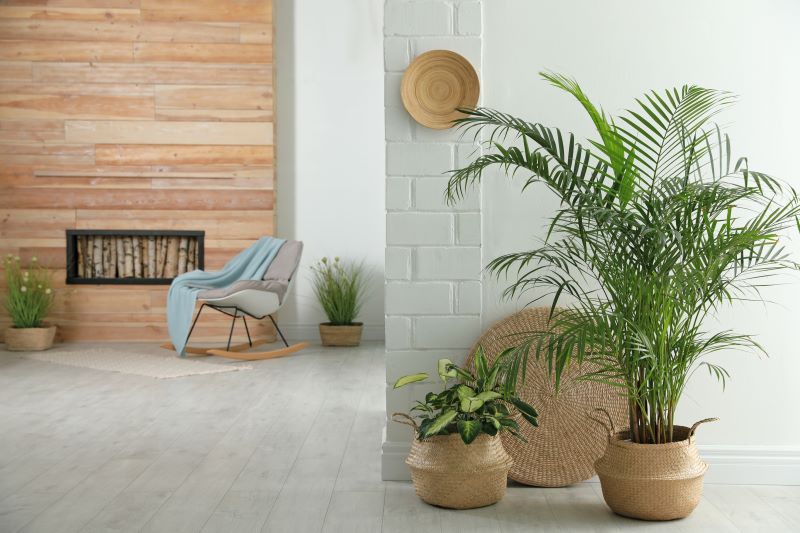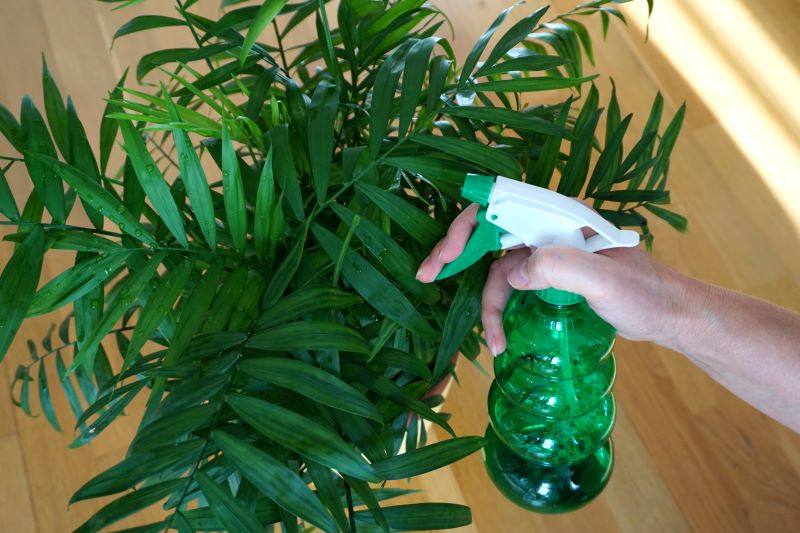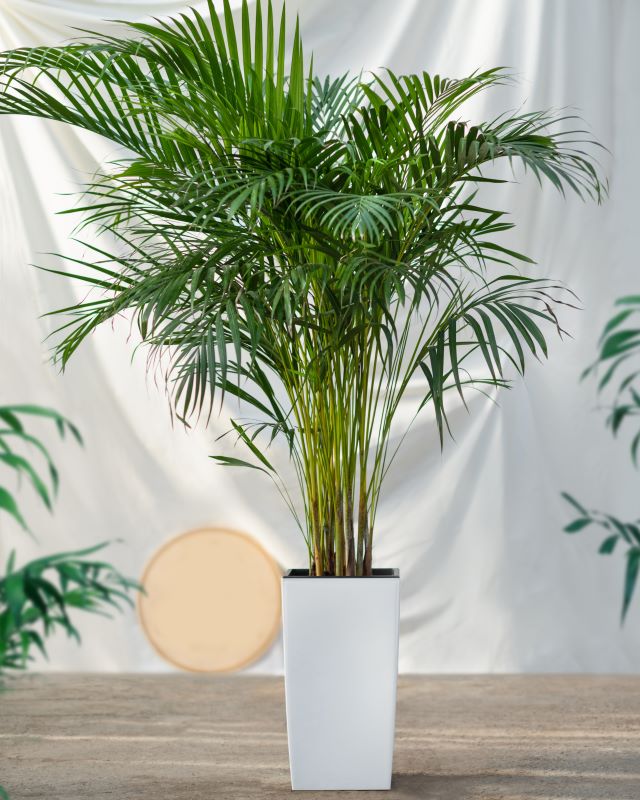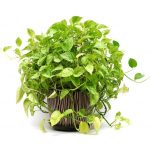The best indoor palms can bring an element of luxury to any home, reminding us of lush, green tropical forests. Palms are a stunning addition to any houseplant collection, adding height and interest. Not all palms are suitable for indoor growing, however, so this guide will give tips on which palms are best for indoor spaces as well as tips for how to care for and get the best out of your plant. We’ll also give you a list of some of the best indoor palm trees and a guide for indoor palm tree care.

3 of the Best Indoor Palms
This very popular indoor palm tree, also known as the Golden Cane Palm, boasts narrow fronds that look similar to bamboo leaves. Full grown, they can reach up to 7 feet. Areca is one of the few palms that can handle trimming without serious harm, and can be pruned to keep it the right size for indoors for many years.
Parlor Palm (Chamaedorea elegans)
This majestic, sturdy palm has lush fans of foliage is slow-growing and easy to care for. Kentia has large, palm-shaped leaves and can grow up to 12 feet indoors. It can tolerate shade and some cold, and is also an air purifier.
Kentia Palm (Howea forsteriana)
This majestic, sturdy palm has lush fans of foliage is slow-growing and easy to care for. Kentia has large, palm-shaped leaves and can grow up to 12 feet indoors. It can tolerate shade and some cold, and is also an air purifier.
Areca Palm (Dypsis lutescens)
This very popular indoor palm tree, also known as the Golden Cane Palm, boasts narrow fronds that look similar to bamboo leaves. Full grown, they can reach up to 7 feet. Areca is one of the few palms that can handle trimming without serious harm, and can be pruned to keep it the right size for indoors for many years.
Caring for Your Indoor Palm Trees
Light
Most palms like bright light, and so are not appropriate for indoor use, but the best indoor palms thrive in low light. Place your palm in indirect sunlight, but be careful not to place it in full light as the leaves can get burnt. Continuous low light can cause palms to stretch and weaken.
Water
Palms are tropical plants, so they like a regular water schedule. As long as they are planted in well-draining soil and are not sitting in water they can be watered regularly. Regular watering can make your indoor palm grow faster. They can be watered up to twice a week, depending on how dry your home is. To test if your palm needs water, stick your finger 2 inches into the soil, and if it feels dry it needs watering. This should be done every 3-5 days. After watering, make sure to empty your drip tray so your palm isn’t left sitting in water.
Distilled water is recommended for growing the best indoor palms. Tap water contains a lot of salts, which can build up on the roots after a few months of watering and cause root damage. To prevent this, it’s recommended to leach your palm every 3-4 months. To do this, put your palm outside and water thoroughly a few times to rinse out the soil. Fertilizer can also cause salt build-up, so it’s a good idea to leach your indoor palm even if you are using distilled water.
Temperature
Just like palms in the tropics, indoor palm trees like warmth. They like wet heat though; too much dry heat can cause leaf and root damage. Avoid putting your palm in front of heaters or a/c units, and keep out of unheated rooms in the winter.
Humidity
Many palms need high humidity, though some varieties are fine with lower humidity. All palms appreciate having their leaves misted regularly with distilled water.
Fertilizer
Indoor palms need less fertilizer than outdoor palms because certain varieties thrive with less light, heat, humidity and with cramped roots. Over-fertilization can burn your palm’s roots. To grow the best indoor palms it is recommended to only fertilize 2-3 times per year.

Pruning
Indoor palm trees are not often pruned because they are monocots, meaning their trunks don’t grow outwards the way other trees do, and they grow one leaf at a time. Use extra care if you are going to prune your palm. Be careful not to damage the trunk, as it might not heal. Prune only in the spring or summer, when you will be able to see which leaves are healthy or not. Remove leaves if they are loose or discolored, but if a leaf doesn’t come off easily, leave it alone. If your palm has flowers or fruit stalks, remove them as they will weaken the plant.
Soil
Use a loose, porous mix of soils, such as peat moss, leaf mold (partially decomposed shredded leaves), and shredded bark. Some places sell palm soil specifically for growing the best indoor palms. Most palms do well with a regular indoor plant soil, though.
Repotting
Only repot your palm if it really needs it, as they enjoy being rootbound. If you plant your palm in a plastic pot, it will be easy to tell if it needs repotting as the roots will break open the pot. Most expert growers will plant palms in a plastic pot which they place inside a ceramic pot. If your palm needs to be repotted, choose a pot that is only slightly bigger.
Indoor Palm Tree Troubleshooting
- Reddish-brown dead areas on leaves
Caused by cold injury. Move your palm to a warmer area of your home.
- Tips of leaves turning brown
This is caused by excessive fertilization. Scale back on fertilizing.
- Leaves are brown
The air is too dry, or the plant needs more water. Be sure to check the water levels, and mist the leaves.
Pests
- Spider mites: these pests are very common, and are rarely noticed until significant leaf damage occurs. The damage will be stippling of the leaves until they look pale and bleached. You can sometimes see fine webbing under the leaves, so watch out for that. Spider mites love dry, still air, to make sure to increase the air flow, mist the leaves frequently, and use an insecticidal soap as needed.
- Mealybugs: these pests are less common but are easier to see. They suck the sap out of leaves and stems and cause stunted and deformed leaves. They look like clumps of white, fuzzy stuff. You can treat your plant with an organic insecticide, or for an easier fix, touch the mealybugs with a rubbing alcohol-soaked cotton ball.
Are The Best Indoor Palms Toxic
Most of the best indoor palms are safe for children and pets, though some are not, so make sure to check specific varieties.
Interesting Facts
- Some of the best indoor palms can live for more than a hundred years!
- Palms may be the oldest living trees.
- The palm branch symbolizes victory, triumph, peace, and eternal life.
Do’s and Dont’s
Do’s
- Place your palm near a heating or cooling source
- Fertilize too often
- Repot too often
Don’ts
- Keep your palm out of direct sunlight
- Water regularly
- Mist the leaves regularly
- Leach your palm every few months

Indoor Palm Tree Care Summary
If you love the tropics but don’t live anywhere near them, or have the money to go there, bring the tropics to you with an indoor palm or two. The best indoor palms are easy to care for, and will last you for years. Stop by your local garden center to choose one of these three recommended palms. Your new addition will bring beauty and warmth to your home, and make you think you took a trip to a tropical island!





